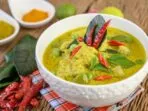How to Cook Rendang, ORIGINAL Minangkabau Recipe
What is Rendang?
Rendang is a rich and flavorful dish originating from the Minangkabau ethnic group of West Sumatra, Indonesia. It is primarily made with beef, which is slow-cooked in coconut milk and a mixture of spices, resulting in a tender and aromatic stew. The dish is often referred to as rendang daging in local languages and is celebrated for its complex flavors and textures.

Historical Background
The roots of rendang can be traced back to early interactions between the Minangkabau people and Indian traders, suggesting that Indian curry may have influenced its development. Over time, the Minangkabau adapted these influences into their own culinary traditions, leading to the creation of rendang. The dish has gained international recognition, often being ranked among the most delicious foods in the world.
Cooking Process and Philosophy
Rendang is characterized by its long cooking process, which not only enhances the flavors but also embodies a philosophy of patience and wisdom in its preparation. The cooking method involves simmering the meat with spices and coconut milk until the liquid reduces and the flavors intensify.
Cultural Significance
Rendang is more than just a dish; it holds cultural significance for the Minangkabau people and is often served during special occasions and ceremonies. Its popularity has spread beyond Indonesia, making it a beloved dish in various countries, particularly in Malaysia and Singapore.
In summary, rendang is a culinary treasure that showcases the rich cultural heritage of Indonesia, combining historical influences with local traditions to create a dish that is both delicious and meaningful.
Common Ingredients in Rendang Preparation

Rendang is known for its rich and complex flavors, achieved through a variety of aromatic ingredients. Here are the common ingredients used in the preparation of beef rendang:
– Beef: Traditionally, rendang is made with beef, although water buffalo meat was historically used. The meat is cut into bite-sized pieces for cooking.
– Coconut Milk: This is a key ingredient that adds creaminess and richness to the dish, helping to tenderize the meat during the slow cooking process.
– Spices: A blend of spices is essential for the distinctive flavor of rendang. Common spices include:
– Ginger
– Garlic
– Shallots
– Lemongrass
– Galangal (a type of ginger)
– Kaffir Lime Leaves
– Coriander
– Cumin
– Nutmeg
– Star Anise
– Cardamom.
– Chilies: Both fresh and dried chilies are used to provide heat and depth of flavor.
– Tamarind Paste: This ingredient adds a tangy flavor that balances the richness of the coconut milk.
– Desiccated Coconut: Sometimes added to thicken the sauce and enhance the coconut flavor.
These ingredients are typically pounded together to create a spice paste, which is then cooked with the beef and coconut milk until the meat is tender and the flavors are well developed. The slow cooking process is crucial, as it allows the spices to infuse the meat thoroughly, resulting in the dish’s signature taste and texture.
Cooking Time for Rendang

The cooking time for rendang can vary significantly depending on the method used and the desired tenderness of the meat. Here are the typical timeframes:
– Traditional Slow Cooking: Traditionally, rendang can take anywhere from 8 hours to 3 days to cook. This long cooking time allows the flavors to develop deeply and the meat to become incredibly tender.
– Modern Cooking Methods: If using a multicooker or Instant Pot, the cooking time can be reduced to about 3 hours. This method still yields a flavorful dish but significantly shortens the overall preparation time.
In summary, while traditional rendang requires patience and time, modern techniques can make it more accessible for home cooks looking to enjoy this delicious dish without the lengthy wait.






